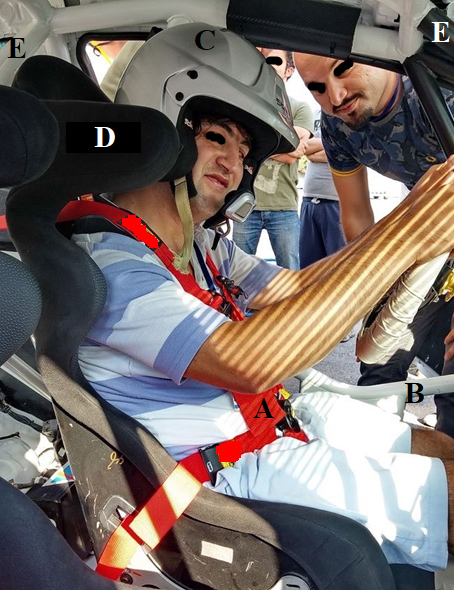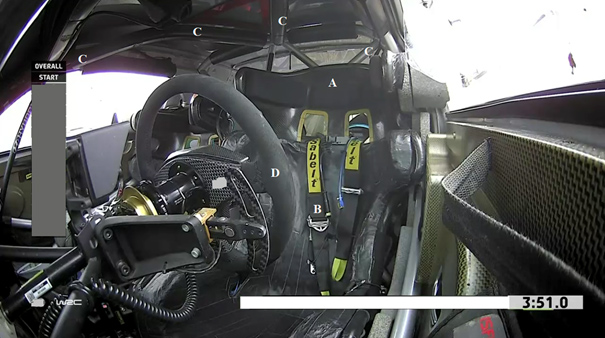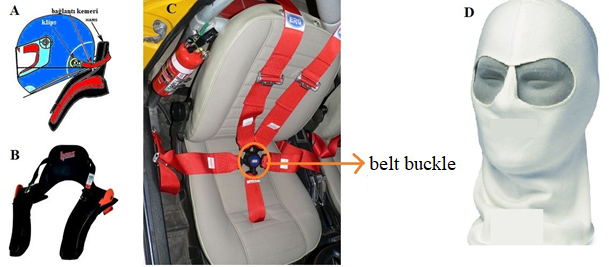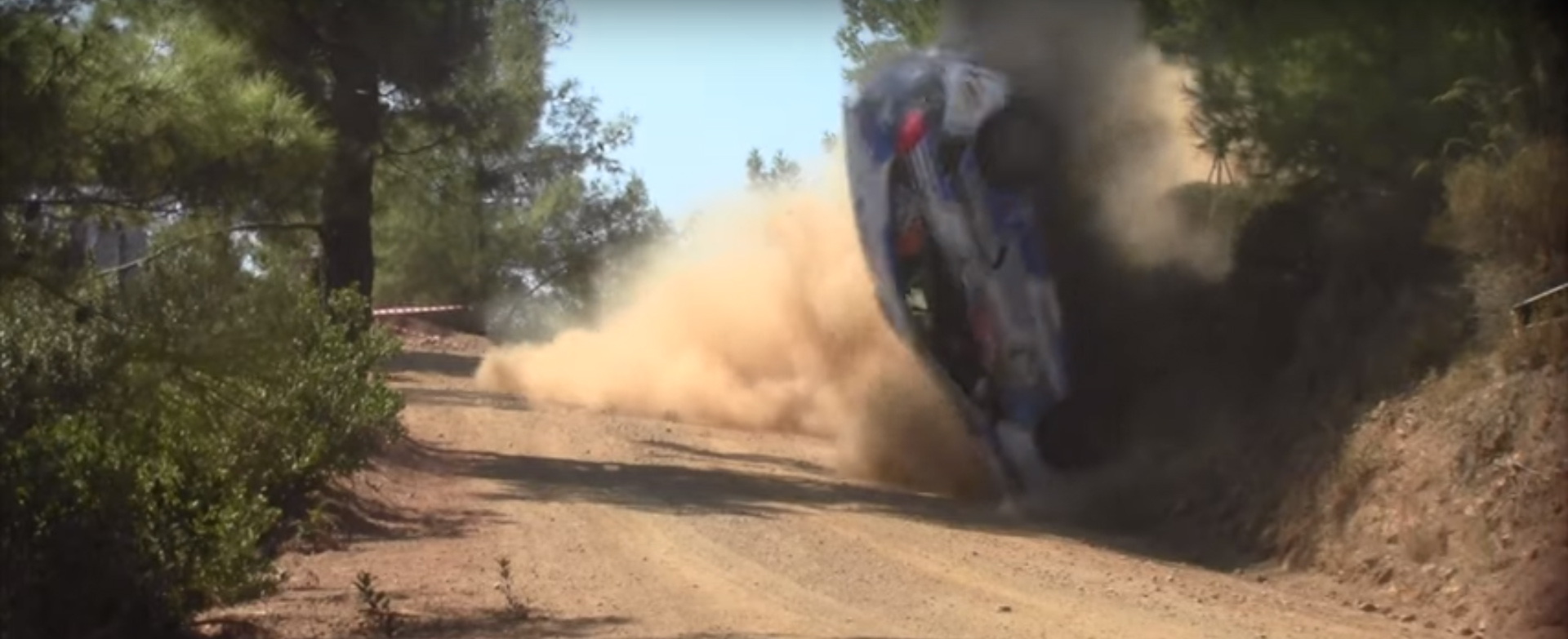International rally events, such as the World Rally Championship (WRC) and the Bosphorus Rally and the World Rally Cross Championship (WRX), have been held in Turkey from 2014 onwards. In all three rally organizations, the International Rally Federation (FIA) pay painstaking attention to the points, such as race safety and safety of drivers as well as medical plan.
The rally car accidents and spectator accidents that occurred in the international rally races held in Turkey (WRX, Bosphorus Rally, the WRX and WRC 2018 Turkey 2019 Turkey) between January 1, 2015 and October 1, 2019 were analyzed retrospectively in the present study. Previous literature data is unavailable to classify rally accidents, thus a new classification was presented. The accidents in the races were watched on the official YouTube page of WRC and on the official website where the WRC racing results were announced. The total duration of the races was calculated by scanning the final result time of all the races from the official sites. The duration of the racers left out of the race until that time was accepted as race time. The accident data recorded retrospectively were analyzed using SPSS for Windows 22.00 (IBM Cooperation, New York). The Fisher Exact test was run to analyze the categorical data, and p ˂ 0.05 was accepted as the boundary of significance.
The total race time of the drivers turned out to be 7 hours 8 minutes 50 seconds in WRX, 47 hours 11 minutes 20 seconds in Bosphorus Rally, 189 hours 55 minutes 51 seconds in WRC 2018, and 113 hours 10 minutes 17 seconds in WRC 2019. The total duration of the race was calculated as 357,43 hours in all races. 52 accidents in total occurred in four international rallies. There were 10 accidents in WRX, 11 in the Bosphorus Rally, 15 in WRC 2018, 16 in WRC 2019. In all the races, the incidence of accidents per race time was calculated as 14.54/100 hours. The accident incidences for WRX, Bosphorus Rally, WRC 2018, and WRC 2019 were 140.04/100 hours, 23.31/100 hours, 8.42/100 hours, and 13.26/100 hours, respectively. The accindent incidences of WRX was found 6 times higher than Bosphorus Rally, 16.62 times higher than WRC 2018 and 10.55 times higher than WRC 2019.
The incidence of Class 1 accidents per race time in the four international rallies was calculated as 12/100 hours, while that of Class 2, Class 3, and Class 6 turned out to be 1.11/100 hours, 1.39/100 hours, and 0.2/100 hours, respectively. The total incidence of the accidents at risk of injury (Class 2 and above) was 3.07/100 hours. No class 4 or class 5 accidents were reported in any race, nor was any urgent intervention needed for the racers. Only one spectator rolled off a 3-4 meter cliff while trying to avoid the vehicle passing very close to the point he was watching. This spectator has removed from the cliff and transferred to the hospital. No fatal injuries were reported.
International rally events carry the risk of severe accidents, definitely necessitating adequate medical support provided by professionals with special training. Emergency medicine physicians are those who can make quick and accurate decisions as well as responding quickly to the patient. No fatal or serious injury accidents in international organizations held in Turkey for 4 years have been reported so far because of the security measures are taken very well. This situation shows the importance of taking correct security measures. It should be noted that accidents led to the death and injury of dozens (spectators, pedestrians, racers) throughout the rally history.
International rally events, such as the World Rally Championship (WRC) and the Bosphorus Rally and the World Rally Cross Championship (WRX), have been held in Turkey from 2014 onwards.
WRX race is an asphalt runway race in which two different categories of vehicles (Super car and RX-Lite) are racing and the rally racers aim to get the first place by passing one another. Super cars have approximately 650 hp engine, RX-Lite cars have approximately 380hp engine. Having been known since 1967, rallycross was organized under the name of WRX in 2014. WRX was held in the Istanbul Park circuit on 01-02 October 2015, WRX has not taken place there again since then, although it still continues in other countries [1].
The Bosphorus Rally inaugurated under the name of Günaydın Rally in 1972 and was renamed as the Bosphorus Rally between 2010 and 2015 after being granted various names and has turned out to be a race that is licensed to assign points to European Rally Championship. Bosphorus Rally organisation has stopped in 2016. Basically it is the type of race on the dirt road, which is made up of several different stages and aims to achieve the best stage time [2].
The international rally inaugurated in 1970 under the name 'International Championship for Manufacturers' and then was organized in 1973 under the name of the 'World Rally Championship' (WRC) [3]. WRC is the type of race on the dirt road as same as Bosphorus Rally. Each year, the race calendar is announced in advance, and after the ranking of the drivers and their scores are calculated, the end-of-season ranking is determined [4]. The vehicle is driven by a pilot, accompanied by a co-pilot who sits in the right front seat and guides the course, and the rankings are created in the categories of pilots, co-pilots and brands. Held in Antalya between 2004 and 2006 and later between 2008 and 2010, WRC Rally of Turkey was re-included in the race calendar for three seasons to be organized in Marmaris after an eight-year interval in 2018.
In all three rally organizations, the International Rally Federation (FIA) pay painstaking attention to the points, such as race safety and safety of drivers as well as medical plan. The 'National Rally Guide Manual', published by Turkey Automobile Sports Federation (TOSFED) in 2019, specifies the measures for car and runway safety, though medical plans remain unmentioned [5].
FIA, in detail, specifies not only driver and road safety but also the plan for medical rescue team in its 2019 'International Sporting Code' guide [6].
In the WRC races held since 1972, 19 racers, including 7 pilots and 12 co-pilots, have lost their lives in rally accidents. While a great number of serious accidents have taken place since 2006, no fatal accidents have been reported in the WRC [2]. It is also noteworthy that co-pilots are more affected by fatal accidents. Co-pilots often look at their notebooks and provide instructions to the pilot from these notebooks during the race, which may lead to their failure to protect themselves at the time of accident. When it comes to the deaths and injuries of the spectators, 9 people (5 spectators and 4 pedestrians) died in the WRC Safari Rally 1978, while 3 spectators were killed and more than 30 spectators were injured in the WRC Rally of Portugal 1986. Furthermore, one spectator died in the WRC 1000 Lakes Rally 1996, and 36 got injured, whereas one spectator died in the Monte Carlo Rally in 2017 [2]. Throughout years, so many security measures are developed and today's level has been reached.
Rally cars in international rallies feature many specifications different from those used in traffic. The changes made to ensure the accident resistance of the vehicle and the safety of the driver are as follows (Figure 1, Figure 2 and Figure 3) [6]:
 Figure 1: Security precautions of the rallycar. A) Seatbelt; B) Side bars; C) Driver's Helmet; D) Driver's seat; E) Top, inner bars.
View Figure 1
Figure 1: Security precautions of the rallycar. A) Seatbelt; B) Side bars; C) Driver's Helmet; D) Driver's seat; E) Top, inner bars.
View Figure 1
 Figure 2: Inside of rallycar. A) Driver's seat (Special designed for driver); B) Seatbelt; C) Inside bars; D) Removable steering wheel.
View Figure 2
Figure 2: Inside of rallycar. A) Driver's seat (Special designed for driver); B) Seatbelt; C) Inside bars; D) Removable steering wheel.
View Figure 2
 Figure 3: Security equipments for rally drivers. A) Helmet and HANS device; B) HANS Device; C) Belt bucket (5 in 1); D) Balaclava.
View Figure 3
Figure 3: Security equipments for rally drivers. A) Helmet and HANS device; B) HANS Device; C) Belt bucket (5 in 1); D) Balaclava.
View Figure 3
• Inserting steel bars in the vehicle (Figure 1B, Figure 1E and Figure 2C).
• Installing an electric and fuel flow cut-off button in the vehicle.
• Nets to cover the whole window (to block out tree branches or other materials from outside).
• Production of custom seats for drivers and co-pilots.
• All seat belts (5 pcs.) attached to a single apparatus to be unlocked easily (Figure 1A and Figure 2B) [6].
Driver safety accessories and functions are as follows:
• Custom-made helmet: To protect the driver from head impacts.
• Balaclava: A fireproof hood to protect from flames (Figure 3D).
• Head and Neck Spine (HANS) (Figure 3B): Neck support to protect the neck from sudden flexion-extension movement.
In this context, medical tasks, accidents and interventions in the rally races held in the last five years, including WRX, BoğaziÇi Rally, 2018 WRC Turkey and 2019 WRC Turkey, will be discussed in this study.
The accidents that occurred in the international rally races held in Turkey (WRX, Bosphorus Rally, the WRC and WRC 2018 Turkey 2019 Turkey) between January 1, 2015 and October 1, 2019 were analyzed retrospectively in the present study.
'Course for Medical Support Services in Autosports' took place in cooperation with TOSFED and Emergency Medicine Association of Turkey on July 24 to 26, 2015, and 25 trainees, the majority of whom were emergency medicine residents, participated in this course [7]. In this course, the participants were trained in emergency extraction, controlled extraction and extraction with a vest called 'Kendrick Extrication Device' (KED). Later, the teams took charge in the medical points of the Bosphorus Rally in the aftermath of the training. This course was similar to the course that was held in Czech Republic in 2010 (Supported by FIA Motor Sport Development Fund) [8].
During the medical team meeting held one day before the WRX, WRC 2018 and WRC 2019 races, the extraction training along with reminder training with KED vest was provided to the assistant health personnel by the medical director theoretically and practically and then practiced by all teams (Figure 1).
For all races, the medical teams were inspected for both practical application and medical equipment on the morning of the start of the race by the FIA medical director, whose approval was pre-prequisite for the start of the races. Provided that the medical director does not grant the approval, the races are canceled.
When an accident has occured, race chief instructs the medical team if racers or spectators need medical invention and then medical team reaches to the accident area by MIC car and race is stopped (if a medical intervention is needed). Medical team extricates the racers (if they could not get out from the car themselves). If the physician needs ambulance, ambulance enters to the race pist and transfers the victim.
The MIC team consisted of two doctors and one paramedic staff, with the driver being an experienced racer. The MIC team was led by a team leader, and the whole team was waiting inside, with the vehicle running. During this waiting time, the instructions of the racing medical director were followed from the radio medical channel. The distance between two MIC points was specified according to the stage conditions in line with FIA Sporting Code Guide. Under this guide, the arrival time to the accident spot did not exceed 10 minutes.
Previous literature data is unavailable to classify rally accidents, thus a classification was presented as follows. The accidents in the races were watched on the official YouTube page of WRC and on the official website where the WRC racing results were announced. The reasons for being out of the race were noted [9-11] (Figure 4). Class four and five accidents identified by watching videos of rally accidents with injuries on YouTube.
 Figure 4: Class 3 accident example in WRC 2019.
View Figure 4
Figure 4: Class 3 accident example in WRC 2019.
View Figure 4
Class 1: The vehicle was damaged and/or left out of race due to a mechanical failure, and there was no or low risk of injury.
Class 2: The vehicle rolled over, but then continued on the road again.
Class 3: A case of roll-over or burning occurred, but the driver and co-pilot left the vehicle on their own. No request for help.
Class 4: The vehicle was damaged due to rolling over the car, rolling into a cliff, crashing into trees or concrete, and either the driver or co-pilot needed immediate assistance and got injured.
Class 5: The vehicle was damaged due to rolling over the car, rolling into a cliff, crashing into trees or concrete, and either the driver or co-pilot needed immediate assistance, or a fatal accident occured.
Class 6a: The vehicle crashed a viewer during a car accident.
Class 6b: A viewer fell down during the accident due to the terrain conditions or stones splashed to a viewer.
The total duration of the races was calculated by scanning the final result time of all the races from the official sites [10]. The duration of the racers left out of the race until that time was accepted as race time.
The accident data analyzed using SPSS for Windows 22.00 (IBM Cooperation, New York). The Fisher Exact test was run to analyze the difference between accident categories, between races and p ˂ 0.05 was accepted as the boundary of significance. The total race time was determined by adding the race time of all riders, and the accident incidence per 100 hours was calculated.
In the Bosphorus Rally with 12 stages in total occuring on two separate days, 6 stages were run on Day 1 and the remaining 6 stages on Day 2. The length of the first 6 stages was 101.5 km and that of the second 6 stages was 91.16 km, which amounted to 192.66 km in total. A 'Medical Interventional Car' (MIC), an 112 ambulance team, a disaster rescue team, and a fire extinguishing team were kept ready in every 10 kilometers.
In the WRX race held on the Istanbul Park circuit, the racers were divided into Supercar and RX lite categories, in which the former included 21 racers while the latter 10 racers. The circuit with a total length of 1.4 km was largely made up of asphalt, with a short segment covered with dirt. While there were five laps on the circuit in qualifying races, semi-final and final races consisted of 6 laps. The racers, each of whom covered 44.8 km during all the races, competed on the same circuit six times in total, including the four qualifying races, the semi-final and final race. The average race speed was 84 km/h., and no co-pilot participated in WRX races as a rule [6].
In WRC Rally of Turkey 2018, held in Marmaris, Muğla on September 13 to 16, a total of 17 stages with a distance of 312.44 km was run. 13 racers competed in the WRC class, 15 racers in the WRC2 class and 15 racers in the WRC3 class.
WRC Turkey 2019 was organized on September 12-15, and included 17 stages and 24 racers in total (10 in the RC1 class, 13 in the RC2 class, 1 in the RC4 class), and each covered 309.86 km.
A total of 859.56 km was covered in 2015 WRX and Bosphorus rally as well as in 2018 and 2019 WRC. The total race time of the drivers turned out to be 7 hours 8 minutes 50 seconds in WRX, 47 hours 11 minutes 20 seconds in Bosphorus Rally, 189 hours 55 minutes 51 seconds in WRC 2018, and 113 hours 10 minutes 17 seconds in WRC 2019. The total duration of the race was calculated as 357.43 hours in all races.
52 accidents in total occurred in four international rallies. There were 10 accidents in WRX, 11 in the Bosphorus Rally, 15 in WRC 2018, 16 in WRC 2019. In all the races, the incidence of accidents per race time was calculated as 14.54/100 hours. The accident incidences for WRX, Bosphorus Rally, WRC 2018, and WRC 2019 were 140.04/100 hours, 23.31/100 hours, 8.42/100 hours, and 13.26/100 hours, respectively.
The number of Class 1 accidents was 10 in the Bosphorus Rally, 7 in WRX 2015, 12 in WRC 2018 and 12 in WRC 2019. Class 2 accidents did not take place in WRX and Bosphorus rally, while 2 accidents each were recorded in WRC 2018 and WRC 2019. Class 3 accidents did not occur in WRC 2019, whereas 3 in WRX, 1 in Bosphorus rally and 1 in WRC 2018 were reported. Class 4 and 5 race accidents were unobserved in all four races. The Class 6b race accidents occurred only once in WRC 2018 and 2019 WRC, respectively (Table 1). The fire incidents were reported in 3 vehicles in WRX 2015, 1 vehicle in Bosphorus rally 2015 and 1 vehicle in WRC 2018. No significant difference was found between the races in the distribution of accidents (p = 0.088) (Table 1). The accindent incidence rate of WRX was found 6 times higher than Bosphorus Rally, 16.62 times higher than WRC 2018 and 10.55 times higher than WRC 2019.
Table 1: Accident incidence rates of rallies. View Table 1
The incidence of Class 1 accident rates per race time in the four international rallies was calculated as 12/100 hours, while that of Class 2, Class 3, and Class 6 turned out to be 1.11/100 hours, 1.39/100 hours, and 0.2/100 hours, respectively. The total incidence rate of the accidents at risk of injury (Class 2 and above) was 3.07/100 hours. There is no significant difference between the Class-2 and above accident incidences between all the races (p = 0.091) (Table 1) but the Class-2 and above accindent incidence rate (incidence/per 100 race hours) of WRX was found 19 times higher than Bosphorus Rally, 26.75 times higher than WRC 2018 and 15.42 times higher than WRC2019. Total incidence rate of all accidents at risk of injury (Class two and above) determined as 3.07/100 hours.
No class 4 or class 5 accidents were reported in any race, nor was any urgent intervention needed for the racers. Only one spectator rolled off a 3-4 meter cliff while trying to avoid the vehicle passing very close to the point he was watching (Class 6b accident). This spectator was taken from the cliff and transferred to the hospital. No fatal injuries were reported.
There is a relatively small body of literature that is concerned with rally accidents and injuries, and we have come across only one study which reports injuries in NASCAR, a circuit race similar to WRX but with a much longer racing time [12]. Because the data in the relevant literature mainly deal with motorcycle and bicycle racing [13-17], we could not find any related studies into the accidents in FIA-controlled WRC, WRX and other international rally organizations during our literature review.
Whole body injuries seen as a result of bike and motorcycle crashes, but it is rare in rally organizations because of the safety precautions. The accident rate was found to be 9.7/100 hours in the study that revealed the accident type and injuries in Moto GP races by Bedolla, et al. [14]. Yanturali, et al. stated injury incidence as 28.2/100 hours in Presidental Cycling Tour of Turkey, an elite road cycling race [13]. Wertman, et al. studied upper limb injuries in NASCAR races between 2003-2014, and noted 14 injuries. Although they did not state frequency of crashes, in 2012 NASCAR Sprint Cup (Championship of 36 races), there were 102 accidents and it is relatively low incidence for a this kind of competition [12]. Incidence that we found in our study is clearly higher than study of Bedolla, et al. for Moto GP races. Especially WRX accident incidence is 16 times of Moto GP races. But rally organizations differs from others, because injury risk free accidents (classified as Class 1) are seen more likely. Both injuries defined by Bedolla, et al. and Yanturali, et al. are more likely to Class 2 and higher injuries in rally races. Class 2 and higher injury incidence in all rally races, is lower than Moto GP and higher than Presidental Cycling Tour of Turkey. This situation points out protective side of security precautions in rally organizations. Incidence of injury free crashes higher than crashes with injuries, and it supports our opinion.
In our study we found that crash incidence was higher in WRX races. Race form of WRX and NASCAR are similar but duration of WRX is shorter. Although WRX race duration is shorter, compared to NASCAR number of accidents are higher [12]. This is probably because of race type such as in WRX drivers do not compete aganist time but compete aganist each other. Class two and higher accident incidence rate is higher than other races and it makes medical team more important.
There has been many accidents in international rally history [2], but there was just one accident which needed medical intervention in four races that we analyzed in our study, this situation shows that race security measures were taken well. Cars can accelerate to 170 kilometers per hour and usually class two or three accidents seen at a speed of over 100 kilometers. It suggests that fatal accidents may occur at that speed so security measures become more important.
Although there ara many accidents in rally races, critical accident incidence is very low. Throughout rally history, critical accidents are classified as four, five and six. It is obvious that a well trained medical team is required for critical accidents although security measures are fine. Due to the content of the education they received, emergency medicine physicians (especially specialists) are more capable to intervene accurately in urgent and risky situations, and they can respond quickly to the patient. While no fatal or serious injury accidents in international organizations held in Turkey for 4 years have been reported so far, it should not go unnoticed that accidents have led to death and injury of dozens of people (spectators, pedestrians, racers) throughout rally history. Thus, one must bear in mind that medical organization is just as important as circuit organization. In addition, this study has some limitations. For instance, no official accident report is kept in race organizations, making it difficult to identify the number of accidents in races. Besides, no assessment could be made regarding the exercise capacity and attention levels of the racers, nor was it was observed whether these parameters created an impact on the accidents.